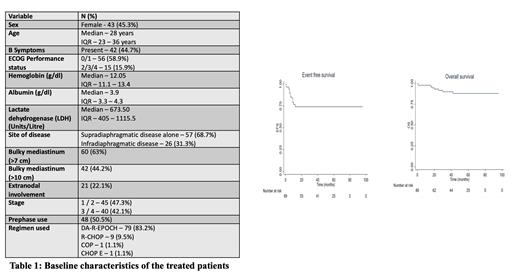The treatment of Primary Mediastinal B Cell Lymphoma(PMBCL) has evolved from R-CHOP and V/MACOP-B chemotherapy to the use of dose-adjusted R-EPOCH(DA-R-EPOCH) after the pivotal NCI trial showed an improved 5 year EFS of 93% and 5 year OS of 97%. The former relied on consolidative RT, whereas the latter omitted RT for most of its patients. Being a rare disease, data from India is minimal. The need for inpatient care for continuous infusion and increased toxicity associated with DA-R-EPOCH, viz., neutropenic fever, mucositis, and neuropathy, makes it a resource-intense protocol.
This retrospective multicentric study collected the data from seven- member centers of Hematology Cancer Consortium (www.hemecancer.org) using an electronic database, to analyze the clinical characteristics, treatment patterns, outcomes, and prognostic factors in newly diagnosed PMBCL diagnosed between 2015-2020. Patients who had received more than 2 weeks of chemotherapy or steroids prior to presentation were excluded. The data included demographic details, performance status (ECOG), CNS involvement, stage, treatment type, response to treatment, and treatment-related mortality as assessed by the investigator of the respective center. The primary objective was to evaluate event-free survival at 2 years. Secondary objectives were to evaluate the 2-year overall survival, the impact of age, Performance Status, stage, treatment regimen, and use of RT on the EFS and OS. Other endpoints included the evaluation of end of treatment response based on the protocol used and to assess the treatment-related toxicities.
A total of 103 patients were included in this study. Of these, 95 patients received treatment and were analysed for outcomes and prognostic factors. There was no significant difference between the treated and untreated cohort. The baseline characteristics of the treated patients are summarized in Table 1. The median age of the patients was 28 years (IQR: 23 - 36). More than half the patients were men(male - 54.7%). B symptoms were present in 42 (44.7%) patients. Close to 60% of patients had baseline PS of 0 or 1 and 70% had only supradiaphragmatic disease. Bulky disease(>7 cm) at presentation was present in 60 patients(63%), >10 cm in 42 patients(44.2%), 21 patients (22.1%) had extra-nodal disease, and 40 patients(42%) had stage III/IV disease. The median LDH at presentation was 673 units/Litre(IQR: 405 - 1117.5).
A total of 79 patients(83.2%) received DA-R-EPOCH as first-line chemotherapy, 9 patients(9.5%) received R-CHOP and the remaining patients received other regimens(COP, CHOP-E). Dose of chemotherapy was compromised in 23 patients (24.2%). Amongst the patient who received DA-R-EPOCH, maximum dose level of 3 or more was achieved in 51 patients(64.55%). Close to 90% of the patients received 6 or more cycles of chemotherapy. End-of-treatment response of CR/PR was achieved in 69 patients(72.7%). Radiation therapy was administered in 44 patients(46.3%) of which 38 (40%) received RT as consolidation after the first line chemotherapy. After a median follow-up of 35 months, 22 patients relapsed, and 8 patients died. 2 year EFS was 74% (95%CI: 69% - 79%) and 2 year OS was 92% (95%CI: 89% - 95%). On univariate analysis, achievement of CR at end of treatment(HR - 0.18; 95%CI- 0.06,0.56; P = 0.003) and receipt of 6 or more cycles of chemotherapy(HR - 0.17; 95%CI - 0.05 - 0.58; P = 0.005) positively impacted the EFS. On multivariate analysis, achievement of CR at the end of treatment (HR - 0.18; 95%CI - 0.06 - 0.56; P - 0.003) was the only factor which impacted the EFS. The treatment-related mortality was 8.4% (8/95). Febrile neutropenia was the most common toxicity seen in 48 patients (50.5%) followed by neuropathy in 10 patients (10.5%).
Our data, one of the largest datasets of PMBCL, highlights the efficacy of DA-R-EPOCH in PMBCL in the Indian setting, albeit with survival lesser than the pivotal NCI trial and the North American retrospective data. The inferior outcomes could have been contributed by the heterogeneity in the first line chemotherapy (16 patients (16.8%) received non-DA-REPOCH regimen), dose compromise (seen in 23% of this cohort) and administration of DAREPOCH at lower dose levels (Dose level of less than 3 in 27%). In contrast to the previous DA-REPOCH trials, close to 40% of the patients received RT as consolidation. Being a retrospective study, selection bias remains a major limitation of this analysis.
Disclosures
Jain:Intas Pharmaceuticals: Research Funding; Zydus Pharmaceuticals: Research Funding; ImmunoACT: Research Funding. Abraham:Pfizer: Research Funding; Sanofi: Research Funding; Novo Nordisk: Membership on an entity's Board of Directors or advisory committees, Research Funding; Roche: Research Funding.


This feature is available to Subscribers Only
Sign In or Create an Account Close Modal